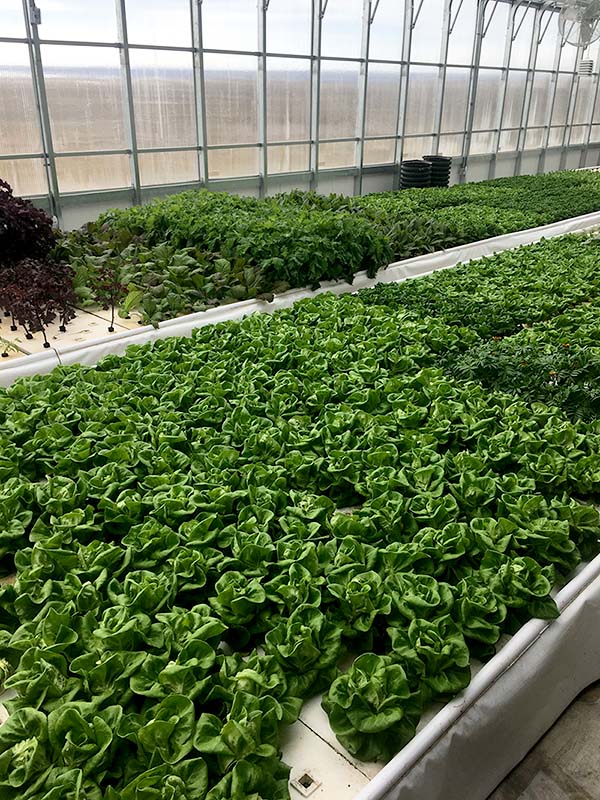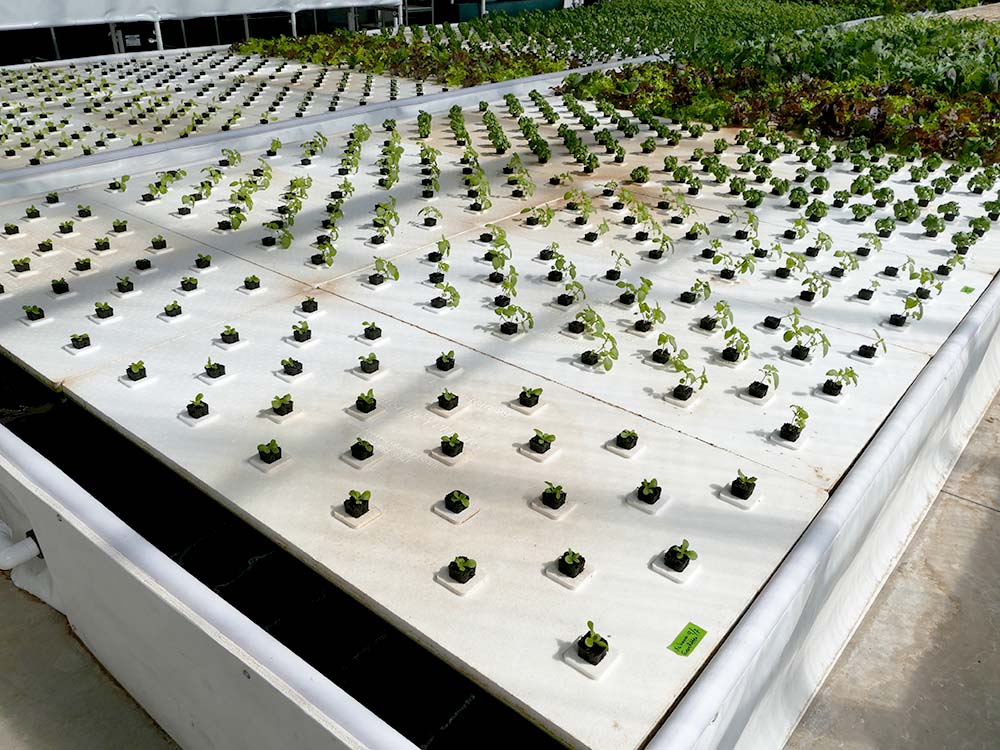While an enticing opportunity, planning a commercial aquaponics greenhouse requires a detailed business plan and a clear understanding of your goals.
 2022 Top Article - A Guide To Planning A Commercial Aquaponics Greenhouse
2022 Top Article - A Guide To Planning A Commercial Aquaponics Greenhouse

Article from | CERES Greenhouse Solutions
Imagine running a business that uses innovative sustainable growing methods, creates little to no waste, and gives back to the community by supplying fresh, local food. Commercial aquaponics presents an opportunity to do all three, while also being financially profitable with high-value, year-round produce.
While an enticing opportunity, planning a commercial aquaponics greenhouse requires a detailed business plan and a clear understanding of your goals.
Let’s discuss three major questions that can help clarify the scale, vision and financial goals for your commercial aquaponics greenhouse. All growers should consider these questions before detailing a business plan and should also read our blog, Can a Commercial Aquaponics Greenhouse be Profitable? (Note: In warm climates some large scale aquaponics farms are located outside. Most growers, however, depend on year-round greenhouses for added climate control and protection for their systems.)

1. Can you be the head grower of a Commercial Aquaponics Farm?
First, do you want to manage the day to day operations of a commercial aquaponics greenhouse? More importantly, do you have the skills to do so? Many growers underestimate the transition from a backyard system to a large-scale aquaponics project. It is important to understand that as a growing method, aquaponics is significantly more complicated than a hydroponic or soil-based commercial greenhouse. Instead of managing one ecosystem – the plants – you are managing two more: the fish and a living bio-filter made of bacteria and worms.
Sylvia Bernstein tactfully sums this up in her book, Aquaponic Gardening:
“The riskiest thing you can do is go to a weekend workshop and think that you are ready to manage a large aquaponics operation. While aquaponics is not too complex once you understand how it all works, you need to grow for a while before you become experienced at recognizing signs of trouble. I can now walk into my greenhouse and instantly know that something is wrong because the sounds and the smells aren’t normal. I can look at the fish and observe their eating habits and tell how healthy they are. I can look at the plants and tell if I have a pH, nutrient or insect problem. I shudder to think what would have happened had I started a large growing operation before honing these skills.”
If you do not have aquaponics growing experience, your options are to start small and learn, or to hire an experienced grower. Large-scale aquaponic greenhouses often hire two head growers – one with a specialty in aquaculture (fish) and one who specializes in horticulture (plants). Experienced growers often recommend setting these up as two potentially independent systems that can, if necessary, be operated on their own. Regardless, identifying who has the knowledge and experience level that is right for your scale is a key first step to planning your commercial aquaponics venture.

2. What is your growth strategy for your aquaponics greenhouse?
A common strategy we see among commercial aquaponic growers is to ‘start small’ and grow the operation slowly. This strategy can and has successfully worked for many growers.
However, others also note that scaling up is not always a linear progression, and the ‘jump’ to a full-blown commercial aquaponics greenhouse poses challenges.
If first investing in a starter greenhouse (1,000 – 5,000 sq. ft.), there may be significant growing pains if transitioning to a large-scale operation (over 10,000 sq. ft.) down the road. One option is to expand incrementally with additional smaller greenhouses. Longtime grower, Rob Torcellini of Bigelow Brook Farm did on his operation in Connecticut:
“We originally started with the dome greenhouse as a test to see how we could grow in the harsh New England weather while refining our aquaponic design and growing techniques. After 3 years of success (and many failures), we decided to minimize our financial risk of expanding into a single 26′ x 144′ greenhouse. Once this greenhouse is operational and we have an established outlet for our produce to create a more stable cash flow, only then will we continue to expand to the next greenhouse. Instead of finding venture capital or large bank loans, we have chosen to personally invest in our own operation. Using our own money is certainly an incentive to watch every penny of the project!”
The downside to growing your commercial aquaponics greenhouse incrementally is that it is a much greater investment (many small structures instead of one large one). It can also lead to inefficiencies with workflow and labor once you have multiple structures. The major pro, as Rob notes, is that risk is contained and you don’t get in over your head. Alternatively, you can transition from a small greenhouse to larger operation by investing in an entirely new structure and hiring an experienced team of growers when you feel comfortable to do so.
At Ceres, we often build modularly, starting with one greenhouse and incrementally adding greenhouses connected by a headhouse and/or corridors. This commercial design philosophy not only saves space, but is engineered to ensure maximum sun harvesting and climate control efficiency. Plus our modular model allows uninterrupted growing, so you can continue to run your business while construction occurs.
As you can tell, there is no one right strategy for scaling the business, but rather many pros and cons of different strategies. It will largely depend on how big you want to start and how big you want to go. It also depends on how the business is funded. Like any business, commercial aquaponics greenhouses can be self-funded or financed with loans. Grants, too, are common supplementary income for non-profit and school greenhouses. Which route you choose is a personal decision, tied to your tolerance for risk, financial situation, ability to get loans and desire to be self-sufficient.
3. What are your top priorities?
In the end, these questions come back to why you want to start a commercial aquaponics greenhouse. Some growers require a significant and immediate return from their investment. Others are primarily motivated by creating business that supports their community with fresh local food, and are less concerned about the financial return. In many cases, we see growers only want to break-even or pay themselves a small salary from the operation, but they don’t expect to make much money.
Whatever your priorities are, it is crucial to evaluate your expected financial return, and diligently create a business plan. If you need assistance in fleshing out the details of a business plan, we recommend utilizing one of the many courses across the country that are tailored to aquaponic greenhouse businesses. (Simply search commercial aquaponics course and you will find a long list of possibilities. We recommend choosing presenters with many years in the business, such as JD and Tawnya Sawyer of The Aquaponics Source.)
An idea of returns is important to flesh out early on, as this will greatly impact the scale of your commercial aquaponics greenhouse. Typically, larger operations are more geared toward profits, due to their greater volume and economies of scale. Large-scale commercial growers must be fairly large in order to achieve the volume required by chain retailers and to compete at scale. Being large, of course, introduces a much higher level of risk, which is why we see many commercial aquaponics greenhouse growers selling produce in local markets from a small or midsize greenhouse.
Identifying your Scale: Putting it All Together
After answering the questions above, you should have a rough picture of your ideal aquaponics greenhouse business. Do you want to fund and manage a small-scale year-round greenhouse on your own? Or, do you want to get financing and run a large-scale aquaponics farm with a team of growers? Or are you somewhere in between – taking out some loans from friends and family, hiring out some of the work while relying on your own experience to operate and run a commercial aquaponics greenhouse? When commercial aquaponics entrepreneurs approach us at Ceres, they usually fall into one of these categories, each of which has pros and cons. To summarize:
- Small-scale commercial (1,000 – 3,000 sq. ft.)
Typical grower: Growers who are new to aquaponics, often creating a small starter greenhouse to gain experience, possibly expanding to a larger operation later. Usually self-funded, these greenhouses do not generate significant profits but can feed friends and family, or supplement a small CSA with year-round produce. Jerome Peloquin refers to this scale as the “sustenance” business model, as it typically provides only for the grower and family/community members, but does not generate significant financial returns.
- Mid-Size commercial (3,000 – 10,000 sq. ft.)
Typical grower: Growers are often entrepreneurs with some aquaponics or commercial greenhouse experience. They want to expand to building a sustainable, community-oriented business. The greenhouse is often managed by a few employees, with the owner often having a hands-on or managerial role (and often have second jobs). Many growers find supplementary income from non-growing operations, such as consulting, events, classes, etc. A larger greenhouse allows for greater production and a more financially stable business. Markets are typically local restaurants and farmers markets.
- Large-scale commercial (> 10,000 sq. ft.)
Typical grower/owner: In these cases, the owner is rarely the main grower. More commonly, the owner is an investor (probably one of several). Greenhouses are more advanced and automated, and run by an organized team (one or more head growers, and several laborers). Outlets for the products are large-scale retailers and food distributors. In these cases, the operation is competing with large-scale hydroponic growers (along with all the other commercial produce). The size imposes a much greater financial risk. But with increased risk, comes the potential for greater returns.
Our close partnership with The Aquaponics Source allows us to design commercial aquaponic greenhouses that are customized to the client’s goals and are guaranteed for success. For more information on our standard or custom aquaponic solar greenhouse designs, visit our aquaponics greenhouse page or contact us today!
The content & opinions in this article are the author’s and do not necessarily represent the views of AgriTechTomorrow
Comments (0)
This post does not have any comments. Be the first to leave a comment below.
Featured Product

